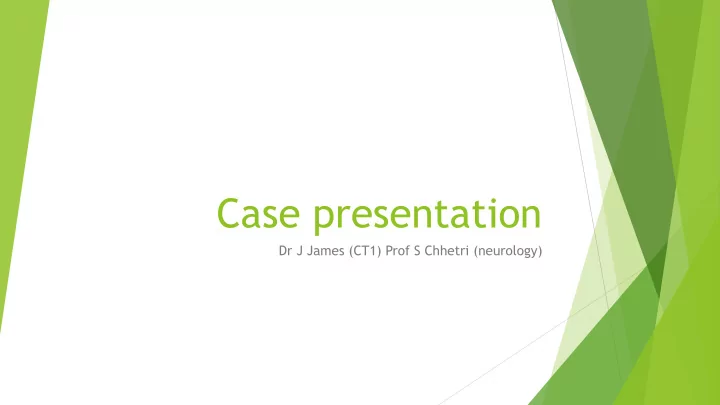

Case presentation Dr J James (CT1) Prof S Chhetri (neurology)
PC & HPC 51 year old lady Presented to Chorley hospital 11/09/17 5/7 of left ear pain and headache 3/7 of left sided otorrhoea N+V, diarrhoea, lethargy Imbalance, Diplopia, confusion and reduced consciousness (GCS 12/15) No cough, CP , SOB, abdominal pain
PMH
MH NKDA
O/E NEWS 3- RR21 HR 110 BP 156/97 temp 37.1 Chest clear, HS normal No photophobia, neck stiffness No facial asymmetry, normal power PERLA, plantars down going Ears: R ear and, L ear: ?perforation/retracted yellow discharge, cloudy TM
DDX? Plan:
Working diagnosis:?CNS infection 2 ◦ to mastoid/middle ear infection CT head Movement artefact Soft tissue opacity filling the left mastoid air cells and middle ear cavity, no erosions or gross dehiscence Appearance similar in right mastoid air cells of the right temporal bone likely inflammatory changes Soft tissue opacity of right frontal sinus , b/l frontal ethmoidal recess, b/l ethmoid left cells, left sphenoidal sinus and b/l maxillary antra All innkeeping with inflammatory mucosal thickening Advised clinical correlation and ENT review
Patient transferred to ENT RPH 11/09/18 To treat as left mastoiditis On iv co-amoxiclav initially Patient continued to complain of left ear pain, headache, lethargy, severe phobophobia and neck pain Neurology review was sort due to this
13/08/19 NEURO R/W
LP results Opening pressure 22 Glucose CSF 3 serum glucose 10.5 (3.5-6) Protein 1.51 (<0.5) CSF lactate 3.70 (<2.8) CSF culture and microscopy Clear, colourless fluid WCC 225- 40% neutrophil 60% lymphocytes Gram stain – no organism seen RBC <1 Sent for viral PCR – HSV, pneumococcal and meningococcal PCR
Bacterial meningitis Rare in adults-10 or fewer lab confirmed cases per year The incidence in adults was estimated to be 1.05 cases per 100,000 population mortality rate of community acquired bacterial meningitis is high, approximately 20% for all causes and up to 30% in pneumococcal meningitis, increasing with age 10% of adults die even with antibiotics due to host response to infection
Symptoms The ‘classic triad’ of neck stiffness, fever and altered consciousness present in less than 50% of cases More unwell/ reduced GCS-bacterial When a rash was present in the context of meningitis, the causative organism was Neisseria meningitidis in 92% of cases 37% of cases of meningococcal meningitis patients did not have a rash Kernig’s and Brudzinski’s signs are not helpful in the clinical diagnosis of suspected meningitis; they have been reported to have high specificity (up to 95%) but the sensitivity can be as low as 5%
Notify! All cases of meningitis (regardless of aetiology) should be notified to the relevant public health authority. The Consultant in Communicable Disease Control (CCDC) or Consultant in health protection in the Public Health England health protection team should be contacted early Prophylaxis of contacts should be initiated by the CCDC/Consultant in health protection and not the admitting clinicians Ciprofloxacin should be given to all close contacts of probable or confirmed meningococcal meningitis:500 mg stat for adult contacts Rifampicin as alternate All meningitis patients should be screen for HIV
Immunosuppression Pneumococcal meningitis – review patients history for immunosuppression Asplenia, splenic dysfunction/ectomy (sub optimal response to vaccine) Complement deficiency On DMARDS (esp Eculizumab/solaris) Should be vaccinated and take prophylactic antibiotics Precautions in meningitis Respiratory isolated and until meningococcal meningitis or sepsis is excluded, or thought unlikely, or they have received 24 h of Ceftriaxone or a single dose of Ciprofloxacin Droplet precautions should be taken until a patient has had 24 h of antibiotics. Antibiotic chemoprophylaxis should be given to healthcare workers who have been in close contact with a patient with confirmed meningococcal disease ONLY when exposed to their respiratory secretions or droplets for example during intubation or as part of CPR when a mask was not worn
Any questions ?
https://www.justgiving.com/fundraising/suresh-chhetri2
Recommend
More recommend